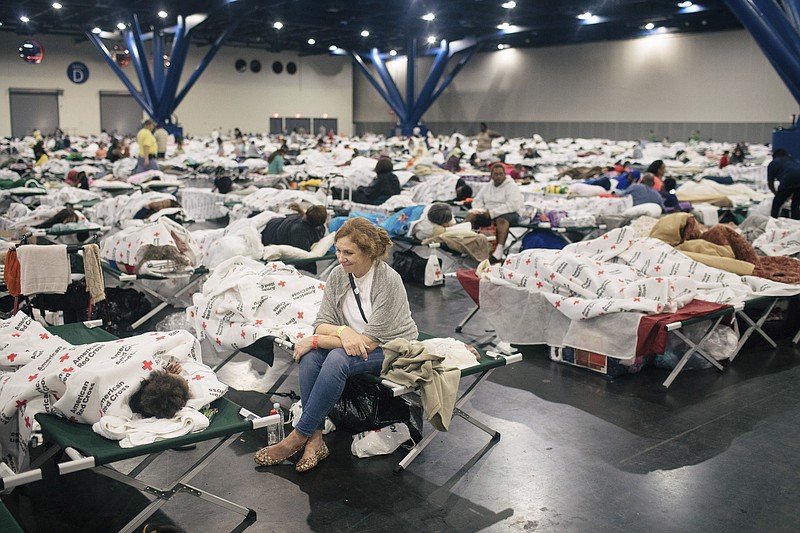South Texas is drowning.
It began when dallying Hurricane Harvey and his storm surge made landfall halfway between Galveston and Corpus Christi, then pirouetted in slow motion just south of San Antonio before heading back out to the Gulf of Mexico for another slurp of heat energy. From there, Harvey is expected to turn back toward Texas and make an even straighter aim at Houston and the rest of the Gulf Coast.
Forecasters don't expect the storm to regain hurricane strength again, but its plodding, easterly track means as much as 25 more inches of rain could fall on the Houston area - on top of the 30 inches of recent days.
Imagine 50 inches of rain in less than a week - that's about as much rain as normally falls in Chattanooga in an entire year. In Houston, the nation's fourth largest metropolitan area, roads have become rivers and thousands of people are stranded, waiting for rescue.
Near Galveston, social media helped rescue a number of elderly women sitting in waist-deep flood waters in the swamped La Vita Bella Nursing Home of Dickinson, Texas. Timothy McIntosh, a dividends manager, posted the photo and an urgent plea for help - sent to him by his mother-in-law who owns the home.
"Need help asap emergency services please RETWEET," wrote McIntosh.
Help came and the elderly residents were saved.
But the rain keeps falling.
Houston already is paralyzed, with 6.6 million people facing days on end of flooding. As of Monday afternoon, at least 10 deaths were reported. Houston did not order evacuations before the storm, countless residents were trapped in flooded homes and the Coast Guard rescued scores from rooftops. Houston police warned residents not to take shelter in their attics "unless you have an ax or means to break through onto your roof."
U.S. emergency management officials expect about 30,000 people will seek emergency shelter, and 450,000 are likely to seek federal aid.
There will also be humanitarian help. One of Erlanger's Lifeforce helicopters has gone to Texas to help, and a Chattanooga-area local Red Cross group is on standby.
We've never seen anything like this Houston flood in our Chattanooga lifetimes, because the last time the Tennessee River took to downtown streets was before the Tennessee Valley Authority filled the river with flood-control dams. But we know what nine tornado touchdowns in 24 hours in Hamilton County alone can do after 2011's four-day outbreak of more than 363 twisters across the South. That outbreak killed 81 people in Chattanooga's tri-state region. Across the South the death toll was 348, and another 2,775 were injured, according to weather.com. Damages totaled $10.8 billion.
In days to come, people will be asking themselves what a deluge of some 50 inches of rain means. Is it just another manifestation of climate change? What lessons will be learned in Houston about our earth and about our preparedness and resilience?
After Hurricane Sandy's 10-inch rainfall combined with storm surge to overwhelm water defenses throughout coastal New Jersey, New York City, Connecticut and Rhode Island, FEMA revised its flood zone maps, placing twice as many homes and businesses in and near New York City in flood-zone areas.
Even here, we see other adaptations from potential future mothers-of-all-floods.
The Brainerd Levee was raised a couple of years ago.
TVA in 2009 announced it would spend about $8 million on temporary sand and gravel baskets to raise the embankments around four dams above Chattanooga by 3 to 4 feet. Some months later, TVA also said it was spending at least $17 million on retrofits at the Watts Bar and Sequoyah nuclear plants to prepare for higher flood threats.
Those local improvements were made partly to remedy TVA's modeling mistakes and changing technologies, but they also were made with a look ahead at changing weather patterns.
In 2012, a University of Tennessee at Knoxville researcher completed a first-of-its-kind study to predict heat waves for the top 20 cities in the eastern United States. His findings put the Tennessee Valley in the cross-hairs of climate craziness with a likelihood of more intense heat waves and - more to today's point - drastically wetter weather.
For this region he predicted as much as 17 inches of extra annual rainfall.
The following year, that's just what we got: Our normal 52.5 inches of rain plus another 16.29 inches to give us a yearly total of nearly 69 inches of rain for 2013, according to the National Weather Service.
Fortunately for us, it didn't all fall in a short period - that time. In 2010, Nashville wasn't so lucky. A two-day, 20-inch rainfall submerged the city and killed 21 people.
Soon we will learn more about Houston and Hurricane Harvey's tragic aftermath.
We'll need to stand ready - both to learn and to offer help.
